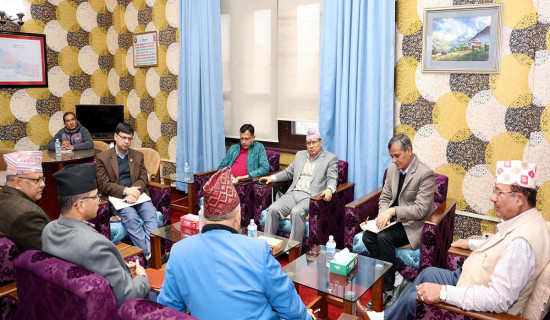- Sunday, 18 January 2026
Mend Medical Education
Dr Navin Yadav
Nestled in the heart of the Himalayas, Nepal boasts breath-taking landscapes, rich cultural heritage and a resilient populace. However, beneath this picturesque facade lies a healthcare system grappling with numerous challenges, chief among them being the state of medical education. While the country has made strides in expanding access to medical education, a closer look reveals a system fraught with inefficiencies and disparities, particularly in the journey of aspiring young doctors.
In recent years, there has been a surge in the number of Nepali students aspiring to pursue a career in medicine. However, the capacity of medical colleges within the country remains limited, leading many talented individuals to seek educational opportunities abroad. While this trend may initially seem beneficial in broadening horizons and fostering global perspectives, it underscores a glaring inadequacy in the domestic medical education system. Upon completing their medical studies overseas, aspiring doctors face a formidable hurdle upon returning home: the internship conundrum.
Unlike their counterparts in neighbouring countries like India, where passing the final MBBS exam grants eligibility for further licensure examinations, Nepali graduates are required to complete a six-month internship to qualify for the National Medical Council (NMC) exam. This prerequisite raises pertinent questions about the logic and efficacy of such a policy. One might argue that the internship requirement serves to ensure that medical graduates are adequately prepared to serve the healthcare needs of Nepal’s diverse population. However, the reality paints a different picture.
The scarcity of internship opportunities within the country often leaves aspiring doctors in limbo, unable to fulfil this requirement despite their academic qualifications. Consequently, many find themselves caught in a bureaucratic maze, unable to embark on their professional journey and contribute meaningfully to the nation’s healthcare landscape. Furthermore, the internship bottleneck exacerbates the brain drain phenomenon, whereby talented healthcare professionals seek opportunities abroad due to frustrations with the domestic system. This not only deprives Nepal of much-needed expertise but also perpetuates a cycle of dependency on foreign-trained professionals, undermining efforts towards self-sufficiency and sustainable healthcare development.
The policymakers and stakeholders should address these systemic challenges with urgency. Reforms must be implemented to streamline the medical education pathway, ensuring that it is equitable, accessible, and conducive to producing competent healthcare professionals who can cater to the needs of the population. First and foremost, efforts should be made to expand the capacity of domestic medical colleges and improve the quality of education they provide. By investing in infrastructure, faculty development, and curriculum enhancement, Nepal can reduce its reliance on foreign institutions and empower aspiring doctors to pursue their studies within the country.
Additionally, reforms should be instituted to revamp the internship system, making it more inclusive and efficient. This could involve establishing partnerships with public and private healthcare institutions to create more internship opportunities and ensure equitable distribution across regions. Moreover, alternative pathways to licensure should be explored, taking into account the diverse backgrounds and aspirations of medical graduates. Ultimately, the goal should be to create an enabling environment where aspiring doctors are supported in their educational journey and empowered to contribute meaningfully to healthcare system.
By addressing the systemic barriers, Nepal can harness the full potential of its youth and pave the way for a healthier, more prosperous future for all its citizens. By reimagining the pathway to becoming a doctor and fostering an environment of innovation and collaboration, Nepal can unlock opportunities for its aspiring healthcare professionals and chart a course towards a brighter tomorrow.
















